Still have questions? Leave a comment

Checklist: Dissertation Proposal
Enter your email id to get the downloadable right in your inbox!

Examples: Edited Papers
Enter your email id to get the downloadable right in your inbox!
Need
Editing and
Proofreading Services?

Business Proposal Guide: How to Write, Examples and Template
 Apr 17, 2024
Apr 17, 2024 7
min read
7
min read
- Tags: Business, Business Writing, Writing Tips
Your business may be great but how do you convey that to the clients? A business proposal is what you need! It is an instrument that can guide you to new partnerships, secure funding, and expand your company’s horizons. Whether you’re pitching services to a potential client or seeking financial backing from an investor, understanding how to make a compelling business proposal is quintessential.
This article will take you through the essentials of what a business proposal is, and its different types. It also has a step-by-step guide on how to create a business proposal, complete with practical tips, examples, and templates!
Let’s begin with an easy business proposal definition:
What is a business proposal?
A business proposal is a formal document that is created to communicate a specific offer or intention to a potential client to secure their business. In simpler words, it is a document designed to offer specific goods or services to a potential client or buyer.
A proposal in business is different from what a business plan is. While a business plan is all about how you run your company, a business proposal is more about convincing others to work with you. It outlines what you can offer, how you plan to deliver your services or products, and why you are the best choice.
Types of business proposals
Business proposals can generally be classified into three types:
Solicited business proposals
These are written when a potential client asks for specific information about your services. The clients are already interested in what you offer and want more details.
Unsolicited business proposals
These proposals are sent out on your own initiative. They’re like a marketing brochure and need to be persuasive to catch the interest of potential clients who might not be actively searching for your services.
Informal and formal proposals
Informal proposals are less structured while formal proposals are structured, outlined, and formal. Informal proposals may look more like a letter. Formal proposals follow a clear outline and are usually more detailed often involving contracts.
Let’s move on to the most interesting part: how to write a business proposal.
How to write a business proposal
Follow this step-by-step guide with practical tips to understand how to write an effective proposal for your business.
Step 1: Understand what the client needs
Clearly understand what the client needs to solve or achieve.
1. Review the Request for Proposal (RFP) if provided, to understand the specific requirements and criteria.
2. Conduct research to gather information about the client’s business, industry trends, competitors, and previous solutions they’ve tried.
3. Communicate directly with the client to clarify any uncertainties about their needs and expectations.
Tip: Make a checklist of what the client wants so you can refer to it as you write your proposal.
Step 2: Create a Title Page
Design a title page that is both informative and visually appealing. Create the title page according to the business proposal format.
1. Include the proposal title, which should be clear and concise, directly addressing the proposal’s purpose.
2. Add the name of the recipient or the company the proposal is addressed.
3. List your company’s name and contact information, including address, phone number, email, and website.
4. Date the proposal to keep track of when the offer was submitted.
5. Incorporate a logo and design elements that reflect your company’s brand.
Tip: Keep the design simple and professional. Avoid cluttering the title page with too much information or overly flamboyant designs.
Step 3: Define what your services will cover
Explain in detail what exactly will your services provide.
1. Start with an executive summary, outlining the key points of the proposal. Include the benefits of how your services will help the client.
2. Write the problem statement, and mention what needs of the client require to be catered to.
3. Specify the solution and deliverables including what services/products will be delivered, and the end results that the client can expect.
4. Set clear boundaries to avoid misunderstandings about your scope, which can lead to unmet expectations and disputes.
Tip: Use bullet points to ensure clarity and that all the deliverables are understood distinctly.
Step 4: Detail your company’s qualifications and experience
Convince the client that your company is the best choice for the project by showcasing your expertise and successful track record.
1. Introduce your company and highlight the achievements to showcase how you are the right choice for the job.
2. Showcase your team’s expertise by briefly introducing key team members who will be involved in the project. Include their roles, experience, and any specific skills or certifications that are relevant to the proposed work.
3. Include testimonials or case studies from similar projects to build credibility.
Tip: Incorporate visuals such as graphs or charts to demonstrate past successes or testimonials in a more engaging way.
Step 5: Make a timeline for the project
Establish a realistic timeline for project completion.
1. Break down the project into smaller phases or milestones.
2. Assign estimated durations to each phase and mark down important dates.
3. Consider potential obstacles that might come up and have a plan for dealing with them.
Tip: Use a Gantt chart to visually represent the timeline, phases, and dependencies.
Step 6: Pricing and budget
Provide the client with a detailed and transparent cost breakdown.
1. List all costs associated with the project, including direct costs, labor, and materials.
2. Offer pricing options if applicable (e.g., tiered pricing for different levels of service).
3. Explain your terms of payment such as due dates for payments, acceptable payment methods, and any payment plans.
4. Add an appendix if necessary for any supporting documents or detailed technical specifications.
Tip: Follow a proper financial statement format to ensure better understanding and record-keeping.
Step 7: Review and edit
Ensure the proposal is polished and free of errors. Also, check and ensure that the business proposal outline has been properly followed throughout.
1. Proofread for punctuation, spelling, and grammar mistakes.
2. Review for clarity and flow, ensuring that the document logically progresses from one section to the next.
3. Get feedback from a colleague or mentor who can provide a fresh perspective.
Tip: Consider using professional proofreading and editing services to refine the proposal further. You can also use proofreading tools such as grammar checkers and content editors if you want to do it yourself. Additionally, you can opt for a proposal writing course to gain structured guidance and enhance your professional writing skills for greater impact.
Step 8: Follow up with the client
Stay in contact with the client even after you send the proposal.
1. Confirm receipt of the proposal with the client.
2. Offer to discuss any questions they might have after reviewing the document.
3. Be proactive about contacting the client to provide additional information and remind them why your proposal is the best choice.
Tip: Set a reminder to follow up if you haven’t heard back within a timeframe that respects the client’s decision-making process.
Now let’s look at some examples of business proposals for a better understanding of the business proposal format and outline.
Business proposal examples
Example 1: Marketing services proposal
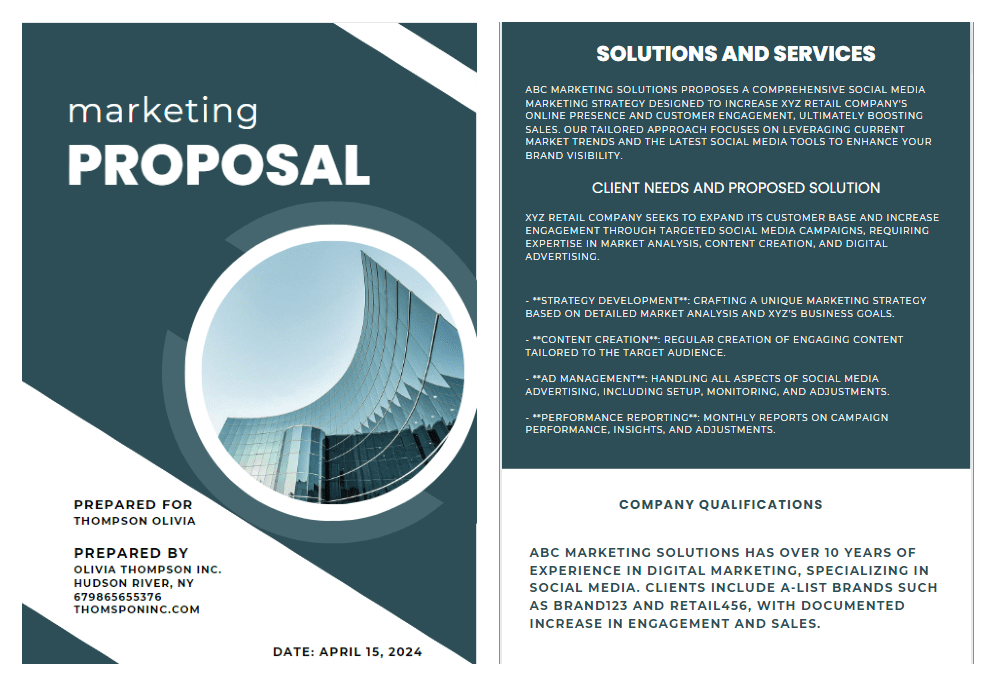
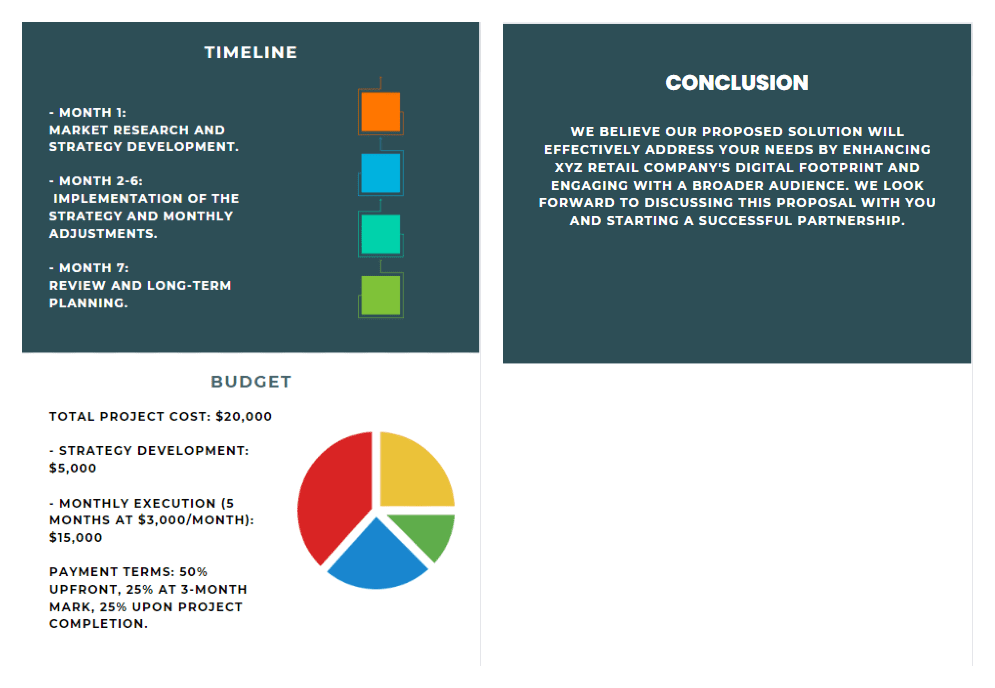
Example 2: Software development proposal
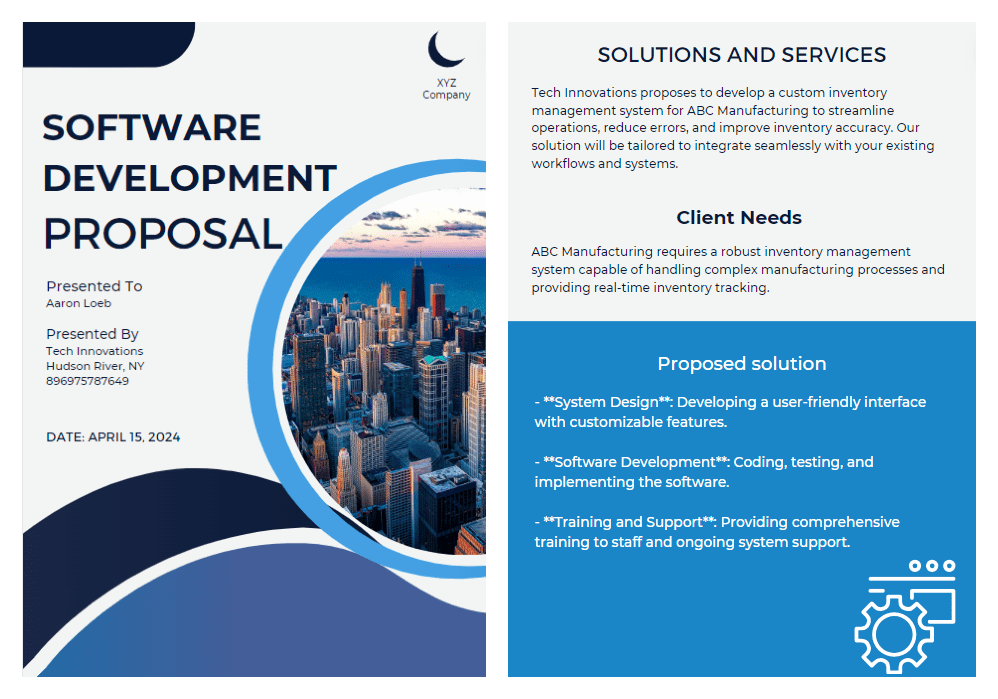
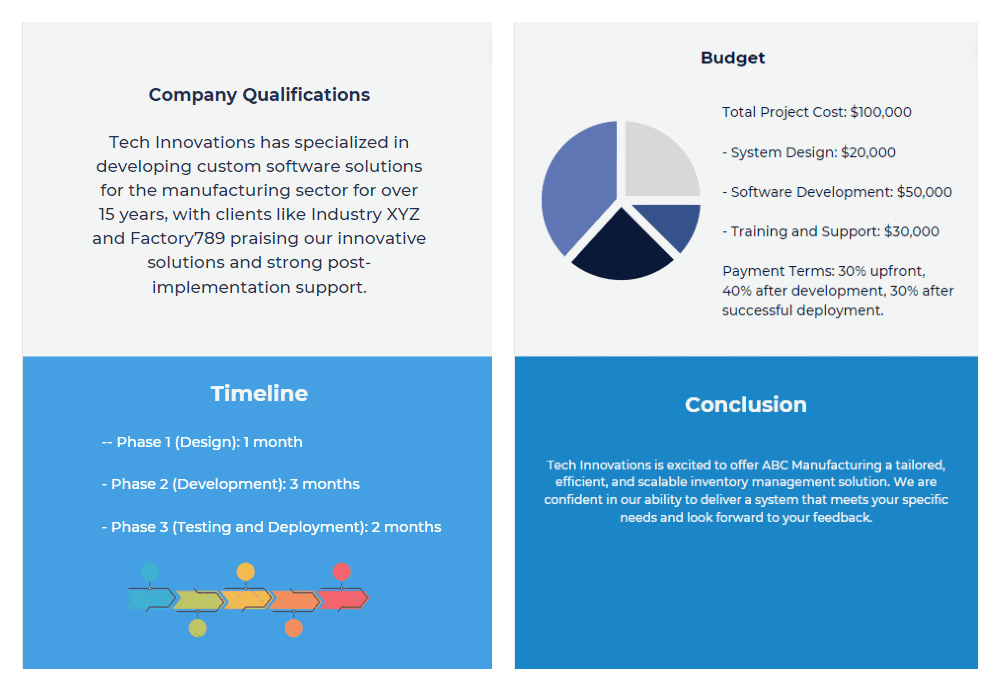
Business proposal template
You can use the given free business proposal template as a starting point for your business proposal. Incorporating the steps mentioned in the guide, you can create a winning proposal for yourself!
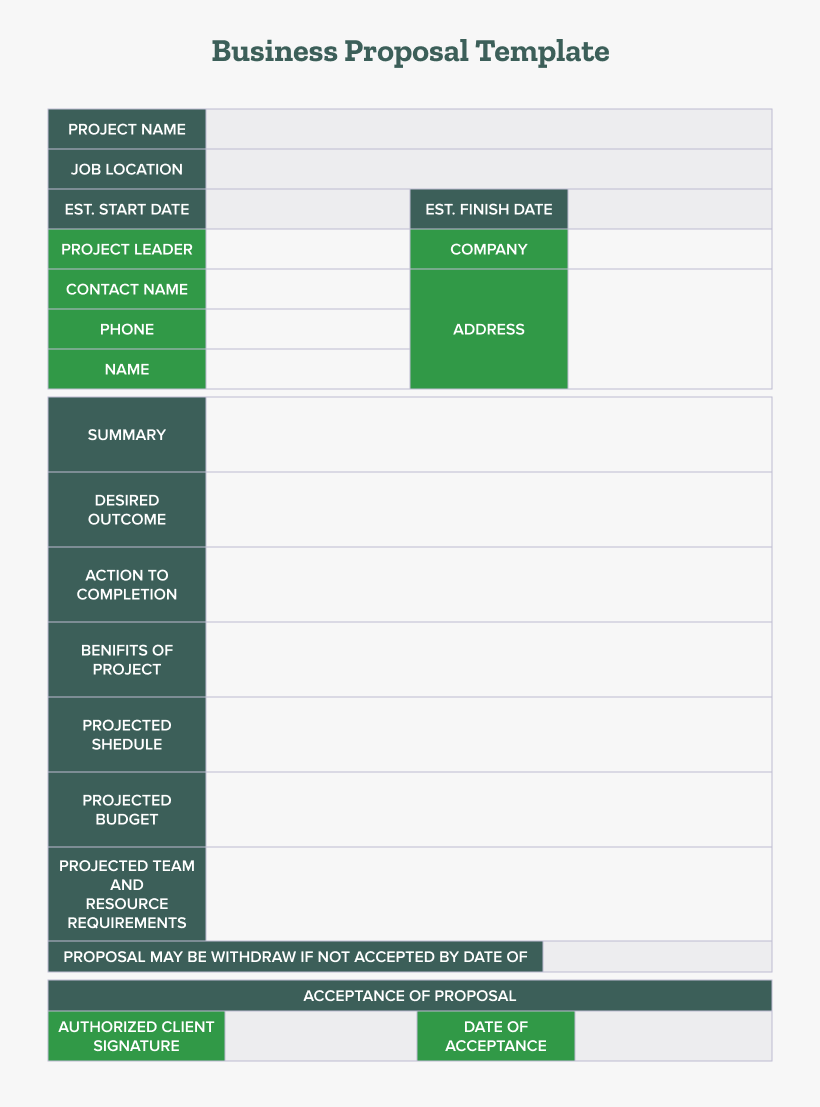
Creating a business proposal doesn’t have to feel overwhelming. By knowing what your client wants and organizing your ideas well, you can write a proposal that not only shows the value of your solution but also lays the groundwork for a successful partnership.
To ensure your business proposal is polished and professional, consider leveraging expert editing and proofreading services offered by PaperTrue. Our team of professionals can help refine your document, ensuring clarity and impact to make the best possible impression on your prospective clients!
Keep reading for more useful resources:






